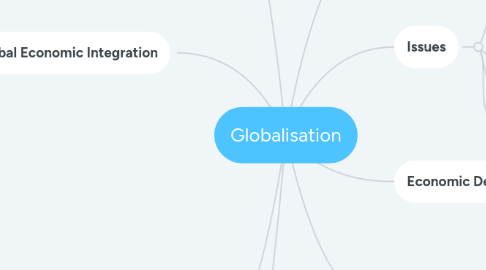
1. Effects of Globalisation
1.1. Caused lower consumer prices, growth and social distribution
1.2. Job automation
1.2.1. Structural unemployment
2. Issues
2.1. Very low interest rates (5000 year low)
2.1.1. Due to increase in efficiency
2.1.2. Globalisation
2.2. Over valued assets (interest rates)
2.3. environmental issues (climate change)
2.4. Debt and demographic change
3. Protection
3.1. Reasons
3.1.1. Governments taking control over trade
3.1.2. Investment flows
3.1.3. Rise of nationalism
3.1.4. Increase over the next decade
3.1.5. China's 1st strategy with technology
3.1.5.1. National defence reason
3.2. Methods
3.2.1. National industrial polices
3.2.2. Research and division through government
4. Global Economic Integration
4.1. Technology
4.1.1. Job automation
4.1.1.1. Disrupts employment
4.1.2. Due to splinternet
4.1.3. Dual tech eco-system
4.1.3.1. Facebook vs. Weibo
4.1.3.2. Whatsapp vs. WeChat
4.2. Investment & TNCs
4.2.1. Government taking control
4.2.1.1. FDI taxes
4.2.2. Bonds less attractive
4.2.2.1. equity and commodities rising attractiveness
4.3. Trade
4.4. Financial Flows
4.5. International division of labour
4.5.1. Automation increases comparative advantage at nations
4.5.1.1. Increase capital
4.5.1.2. Further intrench competitive advantage of developing countries
5. Economic Development
5.1. Peak youth
5.1.1. Ageing population globally
5.1.2. More seniors 65+ than children under 5
5.1.3. By 2100: 65+ reach to 2.3 billion
6. Environmental Sustainability
6.1. Impact investment
6.2. Catastrophic change
6.3. Industrial automation allow for protection in domestic country
6.3.1. Reducing carbon footprint due to transport
6.4. Peak oil
6.4.1. Less petrol
6.4.2. Electronic cars
6.4.3. Renewables
6.4.4. Bold climate action yield eco gain
6.5. Peak "stuff"
6.5.1. Conspicuous assumption ends
6.5.2. Sharing population is popular
6.5.2.1. Uber
6.5.2.2. Airbnb
